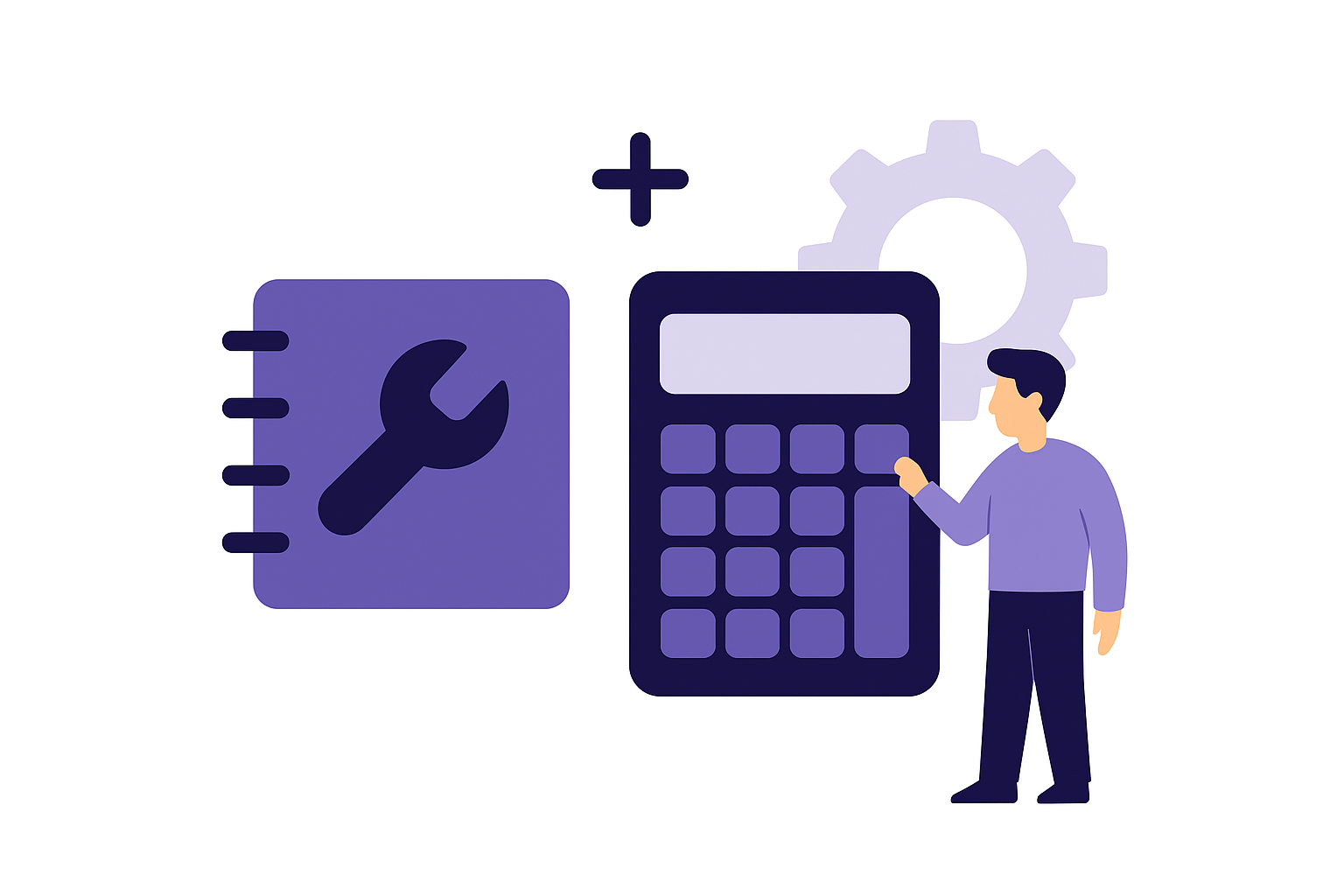Feeling uncertain about whether your project is truly on budget? Our Variance at Completion (VAC) Calculator takes the guesswork out of forecasting by instantly showing you how your estimated final costs stack up against your approved budget.
Whether you’re monitoring burn rate, re-estimating mid-project, or trying to spot overruns before they spiral, this tool gives you a clear, data-driven picture of cost performance. You can input your own EAC or use built-in methods to compute it with EV, AC, CPI, or ETC values, making it flexible enough for any project scenario.
Use it now to pinpoint variance early, guide corrective actions, and keep stakeholders confident that your projects will finish within financial guardrails.
Analyzing every component of the variance at completion calculator + real-world project scenarios
Here's a comprehensive breakdown of each element in the variance at completion calculator, featuring practical examples and project scenarios to help you optimize your budget management strategy and project financial performance.
1. Budget at completion (BAC) input
This field captures your project's total approved budget, establishing the baseline for all variance calculations and financial performance analysis.
Examples:
- Software development: $850,000 (6-month enterprise platform build)
- Construction project: $2,200,000 (commercial office renovation)
- Marketing campaign: $180,000 (quarterly digital strategy rollout)
Why it matters: BAC accuracy determines your variance calculations' reliability and reveals budget planning effectiveness.
2. Estimate at completion (EAC) input
Your current projection of total project costs at completion, reflecting real-world conditions and performance trends.
Examples:
- On-track project: $820,000 (coming in under budget with strong execution)
- Challenged project: $920,000 (scope creep and resource issues driving overruns)
- Optimized project: $850,000 (exactly on budget through effective management)
Why it matters: EAC accuracy reveals project control effectiveness and enables proactive budget management.
3. EAC computation toggle (optional)
An advanced feature allowing automatic calculation when you have earned value management data but need EAC projections.
Calculation methods:
- Typical performance: AC + (BAC - EV) - assumes future work performs as planned
- Past efficiency continues: BAC / CPI - projects current cost efficiency forward
- Inefficiency persists: AC + (BAC - EV) / CPI - factors continue cost performance issues
- Bottom-up estimate: AC + ETC - uses detailed remaining work estimates
Why it matters: Provides sophisticated forecasting when direct EAC estimates aren't available or need validation.
4. Actual cost (AC) input
Total costs incurred to date form the foundation for performance analysis and future projections.
Examples:
- Early stage project: $275,000 (30% complete, tracking well)
- Mid-stage challenge: $580,000 (50% complete, cost overruns emerging)
- Near completion: $785,000 (90% complete, final push within budget)
Why it matters: AC accuracy ensures reliable performance metrics and realistic completion forecasts.
5. Earned value (EV) input
Value of work actually completed, measuring progress against planned deliverables and budget allocation.
Examples:
- Ahead of schedule: $425,000 EV vs. $380,000 AC (efficient execution)
- Behind schedule: $290,000 EV vs. $340,000 AC (productivity challenges)
- Balanced progress: $520,000 EV vs. $515,000 AC (steady performance)
Why it matters: EV reveals true project progress and enables accurate performance trend analysis.
6. Cost performance index (CPI) input
Efficiency ratio showing cost performance trends, either calculated automatically or entered manually for sophisticated analysis.
Performance examples:
- Excellent (CPI > 1.10): Project team: CPI 1.25 - delivering $1.25 value per $1.00 spent
- Good (CPI 0.95-1.10): Marketing team: CPI 1.05 - slight efficiency gains over budget
- Acceptable (CPI 0.85-0.95): Development team: CPI 0.92 - minor cost pressures manageable
- Poor (CPI < 0.85): Construction crew: CPI 0.78 - significant cost overruns requiring intervention
7. Estimate to complete (ETC) input
Bottom-up estimate for remaining work, used when detailed analysis provides more accurate projections than formula-based methods.
Scenario examples:
- Detailed planning: $185,000 ETC (comprehensive task-level estimates for final 15% of work)
- Risk-adjusted: $240,000 ETC (incorporating identified challenges and contingencies)
- Optimistic case: $125,000 ETC (assuming smooth execution through final deliverables)
Why it matters: ETC provides granular control for complex projects where historical performance doesn't predict future costs.
8. Variance at completion (VAC) display
Shows your projected budget variance with contextual analysis based on project management best practices.
Performance examples:
- Under budget (VAC > 0): +$125,000 VAC - exceptional project control and efficiency
- On budget (VAC = 0): Perfect execution matching approved budget baseline
- Slightly over (VAC -5% to -10%): -$45,000 VAC - manageable overrun requiring attention
- Significantly over (VAC < -10%): -$180,000 VAC - major budget crisis demanding immediate action
9. VAC percentage display
Shows variance as a percentage of the total budget, providing context for the financial impact's significance.
Example scenarios:
- Strong performance: +8.5% under budget (efficient resource utilization)
- Minor variance: -3.2% over budget (typical project fluctuation)
- Major concern: -8.3% over budget (substantial financial impact requiring management attention)
Why it matters: Percentage context helps stakeholders understand variance magnitude relative to project scale.
10. Status indicator
Visual performance assessment based on calculated metrics compared to project management standards.
Status categories:
- Under budget: Exceptional performance, potential for additional scope
- On budget: Solid execution, maintain current trajectory
- Slightly over: Monitor closely, implement corrective measures
- Significantly over: Immediate intervention required, stakeholder communication essential
11. Currency and precision controls
Customization options ensure the calculator matches your organization's financial reporting standards and regional requirements.
Configuration examples:
- Global corporation: Multiple currencies (USD, EUR, GBP) with 2-decimal precision
- Local contractor: Single currency (INR) with 0-decimal precision for simplified reporting
- Consulting firm: Professional presentation with appropriate decimal places for client reporting
Complete analysis example
Scenario: Enterprise software implementation project

Input values:
- BAC: $1,200,000 (approved project budget)
- AC: $780,000 (costs incurred through month 8)
- EV: $720,000 (work completed value)
- EAC: $1,300,000 (projected final cost using CPI method)
Results:
- VAC: -$100,000 (over budget)
- VAC percentage: -8.3% (moderate overrun)
- Status: over budget
Analysis: Cost performance challenges indicate scope management issues. CPI of 0.92 suggests ongoing efficiency problems requiring immediate corrective action.
Strategic recommendations:
- Conduct a detailed scope review to identify change drivers
- Implement enhanced cost controls for remaining work packages
- Evaluate resource allocation and productivity improvement opportunities
- Communicate budget challenges to stakeholders with a recovery plan
- Consider scope reduction options to minimize the final overrun
Understanding these calculator components empowers project managers and business leaders to make informed decisions about budget optimization, resource allocation, and project control while ensuring accurate performance measurement for successful project delivery.
Beyond the numbers: When variance at completion tells half the story
Variance at completion (VAC) is powerful, but looking at it in isolation can give a false sense of security. That's why project managers often cross-check VAC against other earned value management (EVM) metrics, like cost variance (CV), cost performance index (CPI), and schedule performance index (SPI).

Together, these metrics paint a truer picture of whether a project is healthy or heading for trouble.
Quick reference table
Cross-check scenarios that matter
VAC negative but CPI ≈ 1
Your costs are efficient, but scope creep or missed rebaselines may be driving the negative variance.
Action: review whether BAC is still realistic or needs updating.
VAC positive but SPI < 1
Budget looks safe, but the schedule is slipping. Delays may cause indirect cost overruns later.
Action: highlight schedule-driven risks before they snowball into cost issues.
CPI > 1 but CV negative
The project is efficient now, but it is still burning through the budget faster than planned.
Action: align reporting intervals and validate EV accuracy.
Key takeaway
Never let VAC stand alone. Always place it next to CV, CPI, and SPI—this way you see both the forecast and the current reality, reducing surprises at project closeout.
Solving VAC calculation nightmares: Your troubleshooting playbook
Even with the right formulas, real-world data often produces confusing results. Below are the most common problems project managers face with VAC, and the corrective actions that keep forecasts reliable.

When VAC shows extreme negative variance
Don't panic at the number alone. First, confirm data accuracy (BAC, AC, and EV entries).
Check whether EAC was inflated by using an aggressive method (e.g., BAC/CPI when CPI < 1).
Corrective actions:
- Run a bottom-up ETC to replace unreliable CPI-driven EAC
- Present both the computed VAC and a scenario-based VAC for management review
How to handle projects with changing scope
Scope creep is a classic VAC breaker. Adding deliverables without adjusting BAC makes VAC look artificially negative.
Steps to fix:
- Re-baseline BAC formally with documented change requests
- Track "original VAC" and "current VAC" separately to maintain transparency
- Clearly note scope-driven changes in stakeholder reports
Dealing with unreliable earned value data
Garbage in = garbage out. If EV isn't tracked consistently, VAC calculations collapse.
Signs of unreliable EV:
- Sudden jumps not tied to deliverables
- EV ahead of schedule with no supporting evidence
- EV values higher than BAC
Fixes:
- Standardize how progress is measured (e.g., 0/100, 50/50, or weighted milestones)
- Reconcile EV with physical completion evidence and milestone logs
- Train teams on consistent EV recording practices
Corrective action strategies for different variance levels
VAC within ±5% → monitor closely, no drastic interventions.
VAC between −5% and −10% → introduce cost controls, renegotiate vendor terms, or trim non-critical scope.
VAC below −10% → trigger a full project re-plan or change request discussion.
VAC positive (>+5%) → explore reinvestment into contingency, scope enhancements, or accelerated delivery.
Treat VAC like a smoke detector, not a crystal ball. If it flashes red, don't just accept the number. Validate the inputs, understand the drivers, and then choose a targeted corrective action.
Gain budget accuracy and strengthen project outcomes
Using the Variance at Completion calculator gives you more than numbers; it delivers clarity, foresight, and control. By comparing BAC and EAC with real-time project data, you can spot risks early, validate scope changes, and take corrective action before costs spiral.
Whether you are managing a complex enterprise build or a lean marketing campaign, this tool equips you to make confident financial decisions and keep stakeholders aligned. Start applying VAC insights today to gain budget accuracy, prevent overruns, and drive stronger project outcomes across every initiative.


%20(1).jpg)
_light%201.png)





